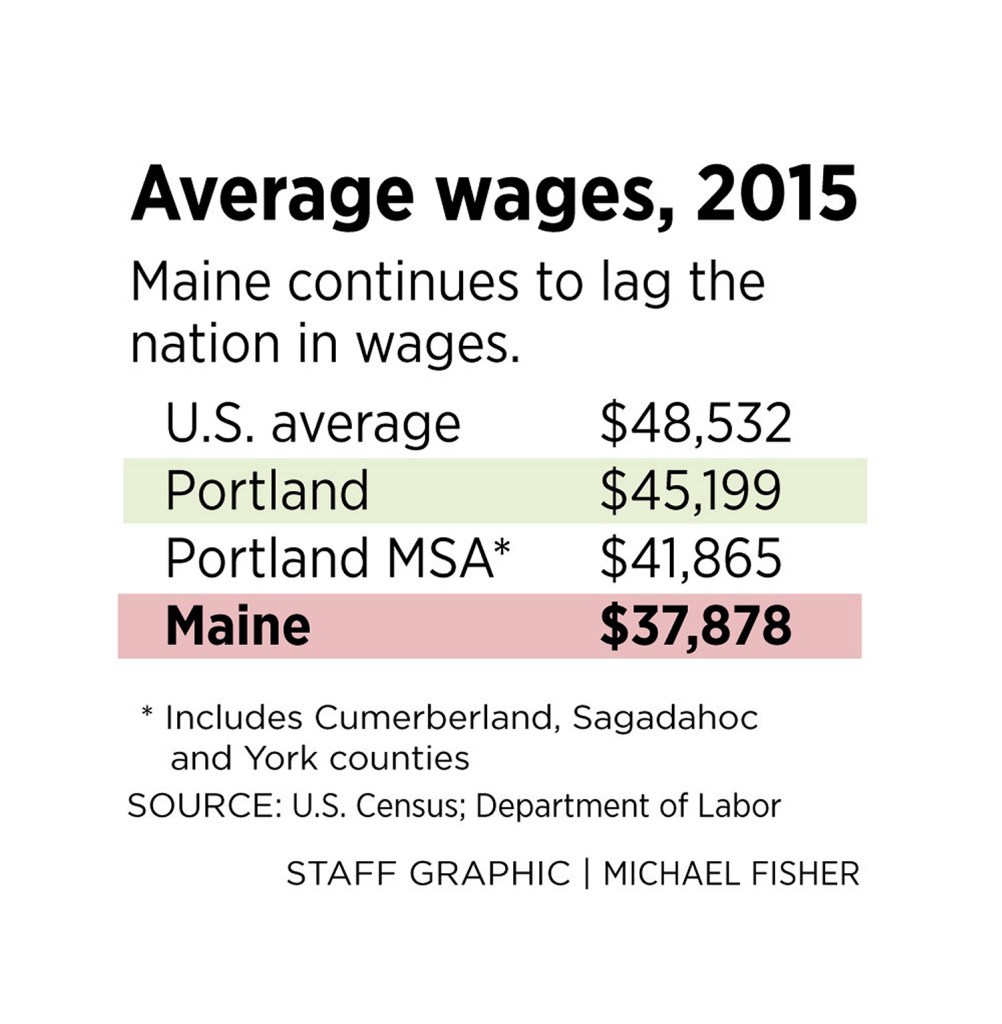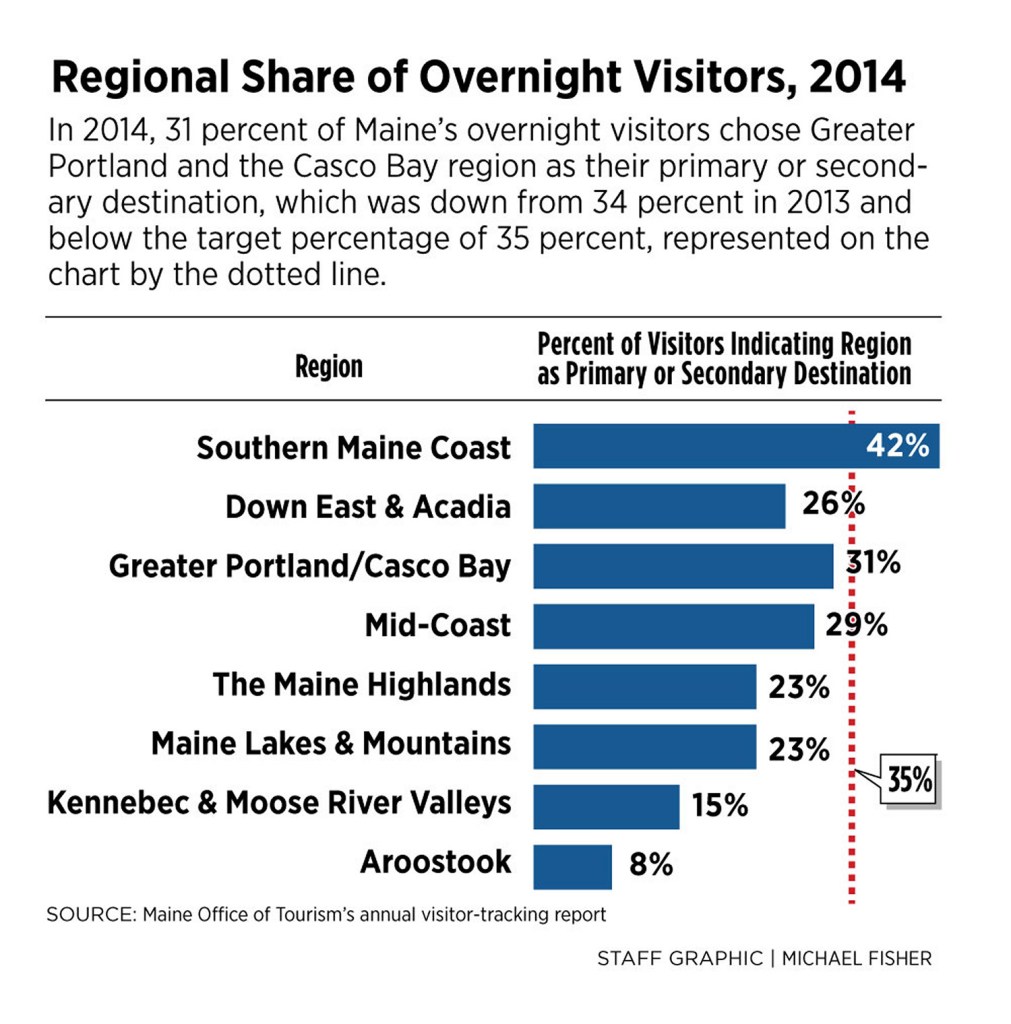The fifth annual Economic Scorecard released by the Portland Community Chamber of Commerce on Tuesday morning shows a slight improvement over last year’s scorecard and a discrepancy between what well-educated Portlanders earn and the cost of living here.
The scorecard, which tracks 28 economic metrics ranging from median city household income to employment levels in creative occupations, compares how the city has performed over the past year against regional and national benchmarks. It then determines if the city is “lagging,” “keeping up,” or “exceeding” its target goals.
The chamber released the report at its first Eggs & Issues event of the season, and the beginning of its 30th year hosting the events. The report was completed by Camoin Associates and the Maine Center for Business and Economic Research at the University of Southern Maine.
In its 2015 scorecard, the city of Portland or its metro area are lagging in 10 areas: employment in food production, average wages, gross metro product growth, growth in value of exports, affordability of home ownership, property tax burden, hotel occupancy rates, overnight visitors, airline passenger counts and Amtrak Downeaster ridership.
Last year, there were 14 areas where the city earned a “lagging” grade.
“I’m very glad to see the recovery in these numbers,” said Chris Hall, CEO of the Portland Regional Chamber of Commerce.
However, Hall also cautioned the community to consider the context of the report. Just because an area is “lagging” doesn’t mean it’s an area where Portland is failing. It only means it didn’t meet the sometimes-ambitious goal the chamber set for that particular metric.
“It would be really easy to have it all green,” Hall said, referring to the depiction in the report of areas that exceed their goals as colored green. “We could have set low goals.”
But that wouldn’t have represented the city’s ambition, he said.
“I think we’ve done a good job of communicating our aspirations through these goals,” Hall said. “We want to be world-class. We want to be as good as anywhere in the world. If our goals seem tough at times, that’s because the competition out there is, too.”
A good example of that is average wages. The city’s average wage during the second quarter of 2015 was $45,199, which was higher than the average wage in the southern Maine region ($41,865) and the statewide average ($37,878). However, the chamber’s goal is to exceed the average national wage, which in the second quarter of 2015 was $48,532.
“The city of Portland is doing far better than the state and yet we tag it as ‘lagging.’ Why? Because our aspiration is to meet the national average or exceed it,” Hall said.
Another area where ambitious goals led to “lagging” grades despite apparent strength is tourism. The report listed four tourism-related metrics as lagging behind their goals: hotel occupancy rates, overnight visitors, airline passengers and Amtrak Downeaster ridership.
In 2014, Portland’s metro area, which the U.S. Census Bureau considers York, Cumberland and Sagadahoc counties, had a hotel occupancy rate of 60.7 percent. The goal was to exceed New England’s overall occupancy rate, which was 63.7 percent in 2014.
“I’m sure if you talk to hoteliers in Portland or the bankers who financed them, I’m sure they’re happy with the occupancy, but we’re lagging because we chose a very aggressive benchmark,” Hall said.
The target for passenger growth at the Portland International Jetport is to exceed the annual growth of the national benchmark cities. From 2013 to 2014, the percent change in passenger counts at Portland’s airport was 0.1 percent compared to the growth at the national benchmark cities of 1 percent. So, the report has Portland “lagging” in this metric. However, Portland’s airport is experiencing a record year. It experienced its best June on record with 170,478 total passengers passing through its gates, and its second-best July ever with 196,881 total passengers.
If you look at the 10-year numbers, passenger count at Portland’s airport increased 14.1 percent from 2005 to 2014, while the passenger counts at the benchmark cities fell 7.8 percent, according to data from the Federal Aviation Administration.
“This is a good example of not passing judgment on a market, but we picked a high benchmark to achieve and we’re not there yet,” Hall said.
The city exceeded its goals in eight areas: employment in financial services and insurance, employment in entertainment and tourism, unemployment rate, growth in value of exports, total consumer retail sales, educational attainment, property valuation and restaurant and lodging retail sales.
“That’s all really positive. That’s not fluff,” said Jim Damicis, senior vice president at Camoin Associates. “However, they still have a cost problem.”
Several of the metrics associated with cost of living, such as the affordability of home ownership, property tax burden and the aforementioned average wages, are lagging behind their benchmarks. Yet the percent of Portland’s population that’s 25 years or older with a bachelor’s degree or higher was 44.8 percent in 2013, which crushed its goal to meet or exceed the educational-attainment percentage at other benchmark cities around the country, which was 35.1 percent that year.
“So we’re highly educated – those numbers are positive – but can we make Portland livable and affordable for workers?” Damicis said. “When it’s that far out of whack, I worry our workers are paying a premium based on their education. In other words, they’re educated, but the economy is not keeping pace with the wages they need to sustainably live there over the long haul.”
Workers aren’t the only ones that impacted by this disparity. Businesses will lose out in the long run, as well, Damicis said.
“They need talented workers and so when we see workers being priced out of the market because of housing costs and other costs it becomes restrictive to their future growth,” he said.
Addressing the wage issue is one of the key takeaways of the report, according to Quincy Hentzel, who became volunteer president of the Portland Community Chamber’s board in July.
“The issues identified in the data are complex, and there are no silver bullets,” Hentzel wrote in an introduction to the report. “The work we have done together to date has had great value – the many positives in the city and the region testify to the good outcomes we’ve achieved. And at the heart of our findings we think it is essential that we clear the way for more jobs, a more prosperous middle class and a stronger set of economic fundamentals.”
The challenges are not just for Portland, though, Damicis said. Workforce and housing issues are regional issues.
“We need to strengthen our regional economic development,” Damicis said. “Everyone has known it forever and we’ve had fits and starts around it, but we simply just need to get there because economies are regional.”
Send questions/comments to the editors.




Comments are no longer available on this story